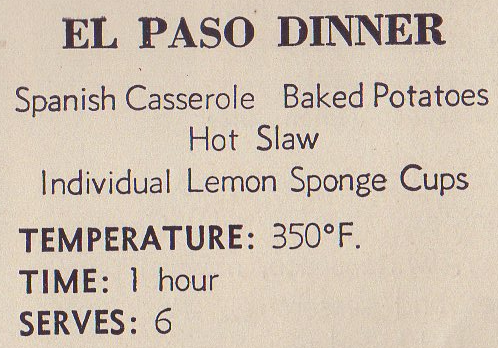I'll admit that I think I overpaid for The American Woman's Food Stretcher Cook Book (1943) because I usually only pay about $2 for these Ruth Berolzheimer-edited collections from the Culinary Arts Institute.
Yeah, I paid $4 for this just because I think World War II-era cookbooks telling cooks how to deal with rationing are fascinating. Plus, I made it worth my while. You see, the booth that sold this also sold a bunch of regional fundraising cookbooks, and I spotted a page of corrections for one of those cookbooks just hanging around loose. Figuring it would probably just get thrown out, as it could take hours to match it to one of those cookbooks (and that's assuming the one it was from hadn't already been sold anyway), I slipped it into Food Stretcher and took it home as a free bonus.
Now I know that "Mom's Marinated Mixed Vegies" should be boiled, not broiled. I'm still puzzled as to how "Flour ingredients unknown" helps with the chocolate cake, though.
Oh, yeah. I was going to write about the book I actually bought, not the page of corrections for an unknown cookbook.... Since meat was rationed during the war, I expected some interesting substitutions. This book really seemed to like peanuts, offering up both Peanut Cutlets...
...and a Cheese and Peanut Loaf.
I like that the cutlets are crusted, which might have made them a little more interesting than the undifferentiated masses of soft stuff that tended to pass for veggie "cutlets" back then. The cheese and peanut loaf may not have been too bad, seeing as how it had actual cheese and did not consist almost entirely of various grains bound with breadcrumbs or a boring vegetable mixture bound with eggs and breadcrumbs.
And of course, there are some obligatory soy bean recipes, like Soybeans à la Creole.
This was back when "Creole" was just code for "with onion, green pepper, and tomato."
Fuel rationing led to menus that cooked everything at once in one appliance, such as oven meals that required only throwing everything into the oven and pulling it out an hour or so later. A lot of the menus didn't sound terrible, but I was not always sure about the themes. How is this collection an El Paso dinner, for instance?
It's sausage wrapped in bacon that's fried and then baked under a layer of veggies and watered-down "catchup." I'm not sure what makes this Spanish or El Paso-esque, but maybe someone out there can tell me?
I'd also think that people in El Paso might be more partial to a refreshing cold slaw than to a hot one.
I guess the lemon sponge cups might make the most sense since lemon trees can be grown in El Paso, at least if the internet is to be believed.
Plus, they look so cute in individual cups.
Not all the recipes seem entirely practical, though. I really wondered about this serving suggestion for beef stew.
Perhaps "You can make yourself famous for a victory special with this wartime beef stew served in crisp cabbage cups," but you'll only be famous as the person who thought trying to serve a stew in cabbage leaves was practical, that it didn't matter that serving it this way would probably make the stew cool off way faster, and also difficult to serve without dousing the tablecloth and/or diners in warm meat chunks. (And if the mixture is dry enough to serve this way, is it even really stew?) I also seriously question the practicality of making the vegetables into a potato-and-carrot-starfish, but it makes for an interesting picture.
In any case, the recipe is wise enough to offer the configuration from the picture as only a variation-- not the preferred method.
My favorite picture in the book, though, is for the Meat Roly-Poly.
The recipe doesn't even hint at the serving method suggested in the picture.
Am I the only one imagining these haunting little pickled peach faces with olive eyes and pimiento features imploring, "Come play with us"?
I don't want to play with you, peach faces, but I have a feeling you are here to haunt me for stealing that loose list of recipe corrections. Crime doesn't pay.














I like how the meals containing meat use more than one type of meat. It doesn't exactly seem like it was being rationed in those recipes. Too bad it wasn't easier to keep livestock in your front yard than growing a victory garden. Of course these days people would starve if food was rationed and they had to cook for themselves.
ReplyDeleteIt is interesting how the meat meals do combine different types rather than sticking to a small amount of a single meat. Arguably, I guess it could be considered a way to use up odd bits of meat, but leftovers are usually already cooked, and these start with uncooked meat.
Delete